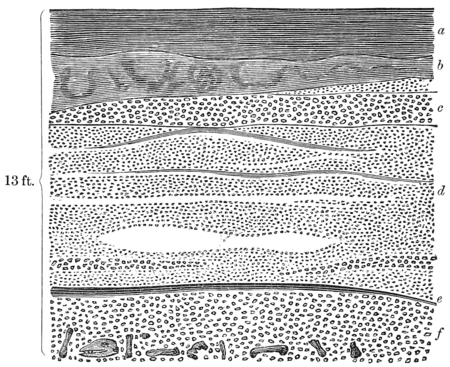to the Acton gravels, is seen in the cross section of the valley which passes through both places (fig. 5). The outcrop of the London Clay is here seen intervening between the two localities, separating the high from the mid terrace. The surface in Brown's Orchard is 24 feet; the stratification of the deposits is shown in Section I (fig. 6),
Fig. 6.—Section I, in Mid-terrace Gravel, in Brown's Orchard, Acton Green. Surface 24 feet.
consisting of:—Surface-soil, 1 foot 6 inches to 2 feet; mixed earth, 6 inches to 2 feet; gravel, 6 inches to 1 foot; 8 feet of sand, with irregular seams of red and white sandy clay; a black seam of oxide of iron or manganese; 2 feet of gravel; and at the bottom of all, in close proximity to the London Clay (which, however, was not attained in this section on account of the quantity of water lying upon it), a thick layer of animal-remains, consisting of a variety of extinct animals, mixed together, and lying invariably at a level 12 to 13 feet from the surface; the names of these, which through the kindness of Mr. Busk I am enabled to give, consist of:—
|
1. Rhinoceros hemitœchus. 2. Equus caballus. 3. Hippopotamus major. 4. Bos taurus. 5. Bison priscus?
|
6. Cervus clactoniensis, Falc. 7. elaphus. 8. tarandus. 9. Ursus ferox priscus. 10. Elephas primigenius.
|
A detailed account of these will be given by Mr. Busk.

